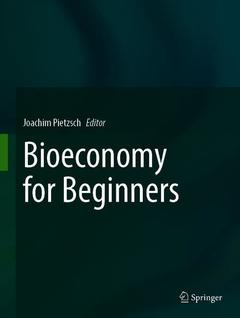Bioeconomy for Beginners, 1st ed. 2020
Coordonnateur : Pietzsch Joachim

This book provides an interdisciplinary and comprehensible introduction to bioeconomy. It thus provides basic knowledge for understanding a transformation process that will shape the 21st century and requires the integration of many disciplines and industries that have had little to do with each other up to now. We are talking about the gradual and necessary transition from the age of fossil fuels, which began around 200 years ago, to a global economy based on renewable raw materials (and renewable energies). The success of this transition is key to coping with the challenge of climate change.
This book conceives the realization of bioeconomy as a threefold task ? a scientific, an economic and an ecological one.
· Where does the biomass come from that we need primarily for feeding the growing world population but also for future energy and material use? How can it be processed in biorefineries and what role does biotechnology play in this regard?
· Which aspects of innovation economics need to be considered, which economic aspects of value creation, competitiveness and customer acceptance are important?· What conditions must a bioeconomy fulfil in order to enable a sustainable development of life on earth? May it be regarded as a key to further economic growth or shouldn?t it rather orient itself towards the ideal of sufficiency?
By dealing with these questions from the not necessarily consistent perspectives of proven experts, this book provides an interdisciplinary overview of a dynamic field of research and practice that raises more questions than answers and thus may nurture the motivation of many more people to seriously engage for the realization of a bioeconomy.
Table of contents
1. Introduction
Joachim Pietzsch, Ulrich Schurr
1.1 The replacement of the original bioeconomy
1.2 The ambivalence of the Anthropocene
1.3 The baseline conditions of a knowledge-based bioeconomy1.4 Starting points for national bioeconomic strategies
2. The origin of biomass
Melvin Lippe, Iris Lewandowski, Rüdiger Unseld, Johannes Pucher, Klaus-Rainer Bräutigam
2.1 Biomass from agriculture
2.1.1 Basic principles of plant production
2.1.2 Basic principles of livestock production
2.1.3 Characterization of agricultural production systems
2.1.4 Material flows and biomass yields
2.1.5 Potentials for increasing biomass production
2.2 Biomass from forestry
2.2.1 The importance of wood as a raw material
2.2.2 The forest location as a production base
2.2.3 Forest use and forest management systems
2.2.4 Possibilities to increase wood production
2.3 Biomass from fisheries and aquaculture
2.3.1 The importance of aquatic organisms2.3.2 The fishing industry
2.3.3 Aquaculture
2.4 Biomass from waste management
2.4.1 Legal basis
2.4.2 Generation and composition of municipal waste
2.4.3 Generation of residual material
2.4.4 Forestry (residual) biomass
2.4.5 Biowaste treatment plants
3. Food security and healthy nutrition in the context of the bioeconomy
Ulrich Schurr
3.1 Forms and consequences of malnutrition
3.1.1 Malnutrition3.1.2 Insufficient supply of micronutrients and vitamins
3.1.3 Obesity3.2 Provision of food and food losses
3.2.1 Food production
3.2.2 Animal feed, efficiency of the use of resources and meat consumption
3.1.3 Biomass and food losses
3.3Food insecurity – a multi-faceted syndrome
4 The use of biomass for the production of fuel and chemicals
Jochen Michels
4.1 The current raw material base of the chemical industry
4.2 Towards bio-based value chains
4.2.1 The chemical classification of renewable raw materials
4.2.2 Platform chemicals from fossil and renewable raw materials
4.3 How biorefineries work
4.3.1 Sugar biorefinery
4.3.2 Starch biorefinery4.3.3 Vegetable oil biorefinery
4.3.4 Lignocellulosic biorefinery4.3.5 Green biorefinery
4.3.6 Synthesis gas biorefinery4.3.7 Biorefinery concepts based on algae
5 The importance of biotechnology for bioeconomy
Manfred Kircher, Michael Bott, Jan Marienhagen
5.1. Biotechnology as a production process
5.1.1 Microorganisms
5.1.2 Enzymes
5.1.3 Plants
5.1.4 Animals
5.2 Perspectives of synthetic biology
5.2.1 BioBricks
5.2.2 Design and construction of synthetic biosynthesis pathways
5.2.3 Synthetic microcompartments
5.2.4 Synthetic genomes
5.2.5 New genetic tools
6 The bioeconomy from the point of view of the innovation economy
Andreas Pyka
6.1 The discontinuity of progress
6.2 Limits to growth?
6.3 Innovation systems and knowledge
6.4 Innovation in knowledge-based societies
6.5 The economy of change
6.6 Transformation as a political priority
7 Bioeconomy as a circular and integrated system
Silvan Berg, Manfred Kircher, Nina Preschitschek, Stefanie Bröring
7.1 The emergence of new value chains
7.1.1 Substitutive convergence
7.1.2 Complementary convergence
7.1.3 New interconnectedness
7.2 Conditions for the formation of bioeconomic value chains
7.2.1 Social requirements and political framework conditions7.2.2 Market and products
7.2.3 Supply chains and logistics7.2.4 Technological complexity
7.3 Perspectives of bioeconomic value chains
7.3.1 Established value chains
7.3.2 Emerging value chains
7.3.3 Future value chains
8 Criteria for the success of the bioeconomy
Stefanie Bröring, Chad M. Baum, Olivier K. Butkowski, Manfred Kircher
8.1 Resolving conflicts among sustainability goals and their solution by eco-innovation
8.2 Competitiveness
8.2.1 A theoretical perspective on the competitive advantages of the bioeconomy
8.2.2 The status quo: the established fossil-based economy
8.2.3 Challenges and requirements for a competitive bio-economy
8.3 Customer and consumer acceptance
8.3.1 Foundations of the acceptance and adoption of innovations
8.3.2 Factors influencing consumer acceptance
8.3.3 Determinants of technology adoption
9 The conditions of a sustainable bioeconomy
Uwe Fritsche, Christine Rösch
9.1 Goals of sustainable development
9.2 Food security
9.3 Land resources
9.4 Water resources
9.5 Biodiversity
9.6 Resource efficiency
9.7 Climate impact and greenhouse gases
9.8 Rural areas
9.9 Conflicting objectives
9.10 Good global governance
10 Bioeconomy – Key to unlimited economic and consumer growth?
Armin Grunwald
10.1 Unlimited growth in a limited world?
10.2 Strategies for sustainable development10.3 Green growth or farewell to growth?
10.4 Bioeconomy and ecomodernism10.5 Hostility to or alliance with nature?
10.6 A learning process on the concept of sustainabilityJoachim Pietzsch is an independent science writer and senior communications consultant based in Frankfurt/Main, Germany.
Bioeconomy presented as a promising subject for the future
Understandably explains the scientific, economic and ecological facets of the project
Renowned contributors
Date de parution : 03-2020
Ouvrage de 214 p.
21x27.9 cm
Disponible chez l'éditeur (délai d'approvisionnement : 15 jours).
Prix indicatif 116,04 €
Ajouter au panier


